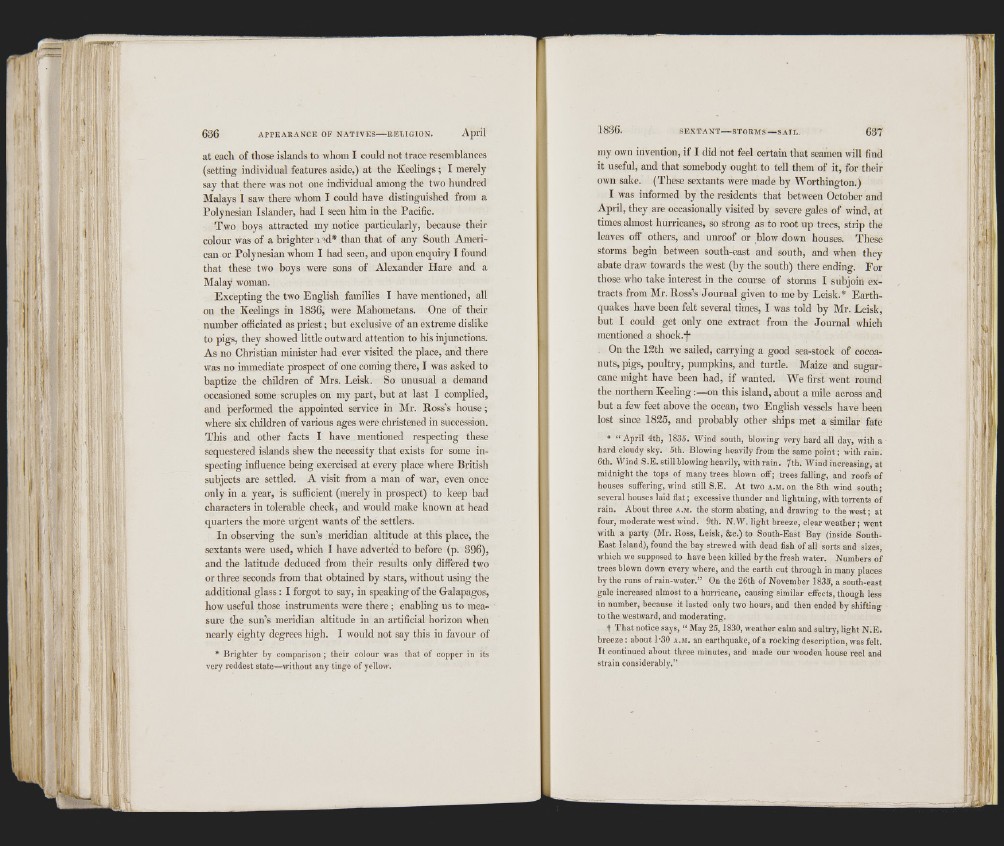
• /„I
li'i i?
at each of those islands to whom I could not trace resemblances
(setting individual features aside,) at the Keelings; I merely
say that there was not one individual among the two hundred
Malays I saw there whom I could have distinguished from a
Polynesian Islander, had I seen him in tbe Pacific.
Two boys attracted my notice particularly, because their
colour was of a brighter i ad* than that of any South American
or Polynesian whom I had seen, and upon enquiry I found
that these two boys were sons of Alexander Hare and a
Malay woman.
Excepting the two English families I have mentioned, all
on the Keelings in 1836, were Mahometans. One of their
number officiated as priest; but exclusive of an extreme dislike
to pigs, they showed little outward attention to his injunctions.
As no Christian minister had ever visited the place, and there
was no immediate prospect of one coming there, I was asked to
baptize the children of Mrs. Leisk. So unusual a demand
occasioned some scruples on my part, but at last I complied,
and performed the appointed service in Mr. Ross’s house;
where six children of various ages were christened in succession.
This and other facts I have mentioned respecting these
sequestered islands shew the necessity that exists for some inspecting
influence being exercised at every place where British
subjects are settled. A visit from a man of war, even once
only in a year, is sufficient (merely in prospect) to keep bad
characters in tolerable check, and would make known at head
quarters the more urgent wants of the settlers.
In observing the sun’s meridian altitude at this place, the
sextants were used, which I have adverted to before (p. 396),
and the latitude deduced from their results only differed two
or three seconds from that obtained by stars, without using the
additional glass : I forgot to say, in speaking of the Galapagos,
how useful tliose instruments were there ; enabling us to measure
the sun’s meridian altitude in an artificial horizon when
nearly eighty degrees high. I would not say this in favour of
* Brighter by comparison ; their colour was that of copper in its
very reddest state—without any tinge of yellow.
my own invention, if I did not feel certain that seamen will find
it useful, and that somebody ought to tell them of it, for their
own sake. (These sextants were made by Worthington.)
I was informed by the residents that between October and
April, they are occasionally visited by severe gales of wind, at
times almost hurricanes, so strong as to root up trees, strip the
leaves off others, and unroof or blow down houses. These
storms begin between south-east and south, and when they
abate draw towards the west (by the south) there ending. For
those who take interest in the course of storms I subjoin extracts
from Mr. Ross’s Journal given to me by Leisk.* Earthquakes
have been felt several times, I was told by Mr. Leisk,
but I could get only one extract from the Journal which
mentioned a shock.#
On the 12th we sailed, carrying a good sea-stock of cocoa-
nuts, pigs, poultry, pumpkins, and turtle. Maize and sugarcane
might have been had, if wanted. We first went round
the northern Keeling:—on this island, about a mile across and
but a few feet above the ocean, two English vessels have been
lost since 1825, and probably other ships met a similar fate
* “ April 4th, 1835. Wind south, blowing very hard all day, with a
hard cloudy sky. 5th. Blowing heavily from the same point; w'ith rain.
6th. Wind S.E. still blowing heavily, with rain. 7th. Wind increasing, at
midnight the tops of many trees blown off; trees falling, and roofs of
houses suffering, wind still S.E. At two a .m . on the 8th wind south;
several houses laid flat; excessive thunder and lightning, with torrents of
rain. About three a .m . the storm abating, and drawing to the west; at
four, moderate west wind. 9th. N.W. light breeze, clear weather; went
with a party (Mr. Ross, Leisk, &c.) to South-East Bay (inside South-
East Island), found the bay strewed with dead flsh of all sorts and sizes,
which we supposed to have been killed by the fresh water. Numbers of
trees blown down every where, and the earth cut through in many places
by the runs of rain-water.” On the 26th of November 1835, a south-east
gale increased almost to a hurricane, causing similar effects, though less
in number, hecause it lasted only two hours, and then ended by shifting
to the westward, and moderating.
t That notice says, “ May 25,1830, weather calm and sultry, light N.E.
hreeze; about 1-30 a .m . an earthquake, of a rocking description, was felt.
It continued about three minutes, and made our wooden hou.se reel and
strain considerably.”
■Ji
•r;
L,
M i
'Isll
, iJ
J I